Copenhagen Business School: Global People Management Assignment
VerifiedAdded on 2022/09/13
|8
|3552
|10
Homework Assignment
AI Summary
This assignment solution addresses key concepts in global people management, HRM, and leadership. It begins by comparing universalistic and contextual approaches to managing global talent, highlighting the importance of considering cultural and environmental factors. The solution then delves into cultural dimensions, examining Schwartz's theory of cultural values, Hofstede's cultural dimensions, and Schein's cultural theory, providing frameworks for understanding cross-cultural differences. The solution also analyzes a case study involving a multicultural team, identifying leadership failures and proposing solutions based on the global assignment cycle, emphasizing pre-assignment planning, on-assignment support, and repatriation strategies. Finally, it reviews an article focusing on the role of effective hiring systems in organizational development, particularly within a global context, and discusses the importance of leveraging cultural and socio-political institutions for competitive advantages. This solution provides a comprehensive overview of key topics, theories, and practical applications within the field of global people management.
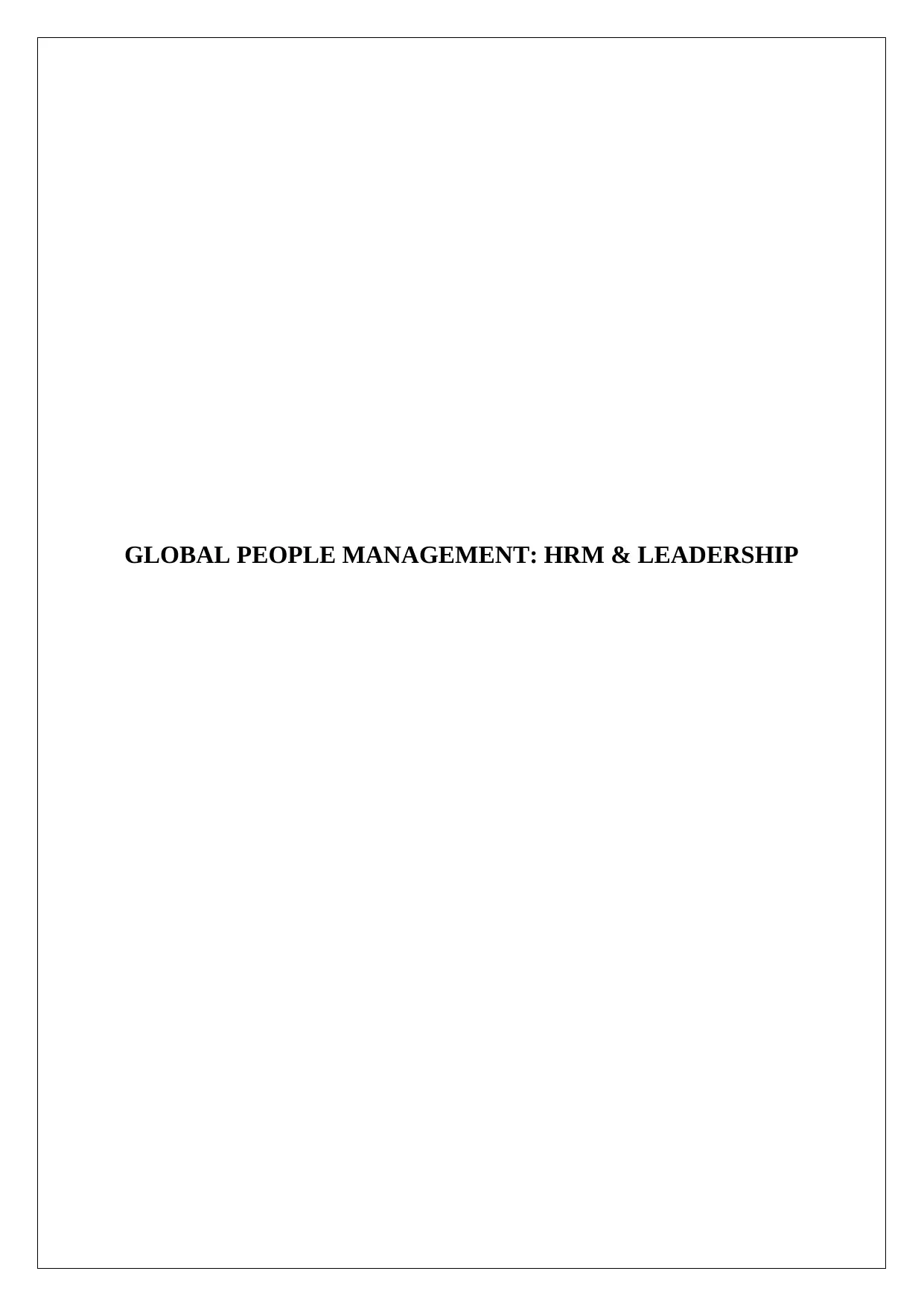
GLOBAL PEOPLE MANAGEMENT: HRM & LEADERSHIP
Paraphrase This Document
Need a fresh take? Get an instant paraphrase of this document with our AI Paraphraser
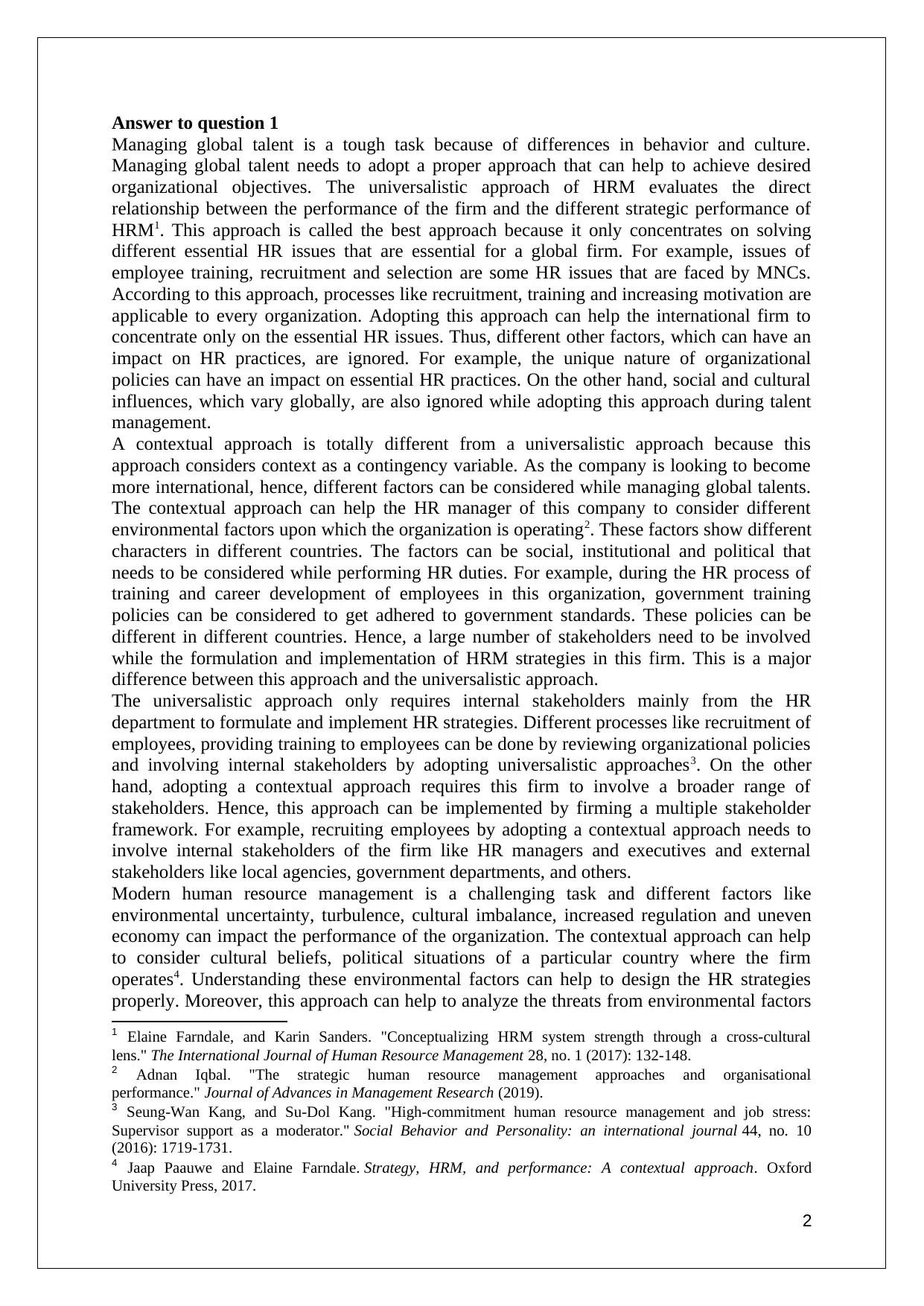
Answer to question 1
Managing global talent is a tough task because of differences in behavior and culture.
Managing global talent needs to adopt a proper approach that can help to achieve desired
organizational objectives. The universalistic approach of HRM evaluates the direct
relationship between the performance of the firm and the different strategic performance of
HRM1. This approach is called the best approach because it only concentrates on solving
different essential HR issues that are essential for a global firm. For example, issues of
employee training, recruitment and selection are some HR issues that are faced by MNCs.
According to this approach, processes like recruitment, training and increasing motivation are
applicable to every organization. Adopting this approach can help the international firm to
concentrate only on the essential HR issues. Thus, different other factors, which can have an
impact on HR practices, are ignored. For example, the unique nature of organizational
policies can have an impact on essential HR practices. On the other hand, social and cultural
influences, which vary globally, are also ignored while adopting this approach during talent
management.
A contextual approach is totally different from a universalistic approach because this
approach considers context as a contingency variable. As the company is looking to become
more international, hence, different factors can be considered while managing global talents.
The contextual approach can help the HR manager of this company to consider different
environmental factors upon which the organization is operating2. These factors show different
characters in different countries. The factors can be social, institutional and political that
needs to be considered while performing HR duties. For example, during the HR process of
training and career development of employees in this organization, government training
policies can be considered to get adhered to government standards. These policies can be
different in different countries. Hence, a large number of stakeholders need to be involved
while the formulation and implementation of HRM strategies in this firm. This is a major
difference between this approach and the universalistic approach.
The universalistic approach only requires internal stakeholders mainly from the HR
department to formulate and implement HR strategies. Different processes like recruitment of
employees, providing training to employees can be done by reviewing organizational policies
and involving internal stakeholders by adopting universalistic approaches3. On the other
hand, adopting a contextual approach requires this firm to involve a broader range of
stakeholders. Hence, this approach can be implemented by firming a multiple stakeholder
framework. For example, recruiting employees by adopting a contextual approach needs to
involve internal stakeholders of the firm like HR managers and executives and external
stakeholders like local agencies, government departments, and others.
Modern human resource management is a challenging task and different factors like
environmental uncertainty, turbulence, cultural imbalance, increased regulation and uneven
economy can impact the performance of the organization. The contextual approach can help
to consider cultural beliefs, political situations of a particular country where the firm
operates4. Understanding these environmental factors can help to design the HR strategies
properly. Moreover, this approach can help to analyze the threats from environmental factors
1 Elaine Farndale, and Karin Sanders. "Conceptualizing HRM system strength through a cross-cultural
lens." The International Journal of Human Resource Management 28, no. 1 (2017): 132-148.
2 Adnan Iqbal. "The strategic human resource management approaches and organisational
performance." Journal of Advances in Management Research (2019).
3 Seung-Wan Kang, and Su-Dol Kang. "High-commitment human resource management and job stress:
Supervisor support as a moderator." Social Behavior and Personality: an international journal 44, no. 10
(2016): 1719-1731.
4 Jaap Paauwe and Elaine Farndale. Strategy, HRM, and performance: A contextual approach. Oxford
University Press, 2017.
2
Managing global talent is a tough task because of differences in behavior and culture.
Managing global talent needs to adopt a proper approach that can help to achieve desired
organizational objectives. The universalistic approach of HRM evaluates the direct
relationship between the performance of the firm and the different strategic performance of
HRM1. This approach is called the best approach because it only concentrates on solving
different essential HR issues that are essential for a global firm. For example, issues of
employee training, recruitment and selection are some HR issues that are faced by MNCs.
According to this approach, processes like recruitment, training and increasing motivation are
applicable to every organization. Adopting this approach can help the international firm to
concentrate only on the essential HR issues. Thus, different other factors, which can have an
impact on HR practices, are ignored. For example, the unique nature of organizational
policies can have an impact on essential HR practices. On the other hand, social and cultural
influences, which vary globally, are also ignored while adopting this approach during talent
management.
A contextual approach is totally different from a universalistic approach because this
approach considers context as a contingency variable. As the company is looking to become
more international, hence, different factors can be considered while managing global talents.
The contextual approach can help the HR manager of this company to consider different
environmental factors upon which the organization is operating2. These factors show different
characters in different countries. The factors can be social, institutional and political that
needs to be considered while performing HR duties. For example, during the HR process of
training and career development of employees in this organization, government training
policies can be considered to get adhered to government standards. These policies can be
different in different countries. Hence, a large number of stakeholders need to be involved
while the formulation and implementation of HRM strategies in this firm. This is a major
difference between this approach and the universalistic approach.
The universalistic approach only requires internal stakeholders mainly from the HR
department to formulate and implement HR strategies. Different processes like recruitment of
employees, providing training to employees can be done by reviewing organizational policies
and involving internal stakeholders by adopting universalistic approaches3. On the other
hand, adopting a contextual approach requires this firm to involve a broader range of
stakeholders. Hence, this approach can be implemented by firming a multiple stakeholder
framework. For example, recruiting employees by adopting a contextual approach needs to
involve internal stakeholders of the firm like HR managers and executives and external
stakeholders like local agencies, government departments, and others.
Modern human resource management is a challenging task and different factors like
environmental uncertainty, turbulence, cultural imbalance, increased regulation and uneven
economy can impact the performance of the organization. The contextual approach can help
to consider cultural beliefs, political situations of a particular country where the firm
operates4. Understanding these environmental factors can help to design the HR strategies
properly. Moreover, this approach can help to analyze the threats from environmental factors
1 Elaine Farndale, and Karin Sanders. "Conceptualizing HRM system strength through a cross-cultural
lens." The International Journal of Human Resource Management 28, no. 1 (2017): 132-148.
2 Adnan Iqbal. "The strategic human resource management approaches and organisational
performance." Journal of Advances in Management Research (2019).
3 Seung-Wan Kang, and Su-Dol Kang. "High-commitment human resource management and job stress:
Supervisor support as a moderator." Social Behavior and Personality: an international journal 44, no. 10
(2016): 1719-1731.
4 Jaap Paauwe and Elaine Farndale. Strategy, HRM, and performance: A contextual approach. Oxford
University Press, 2017.
2
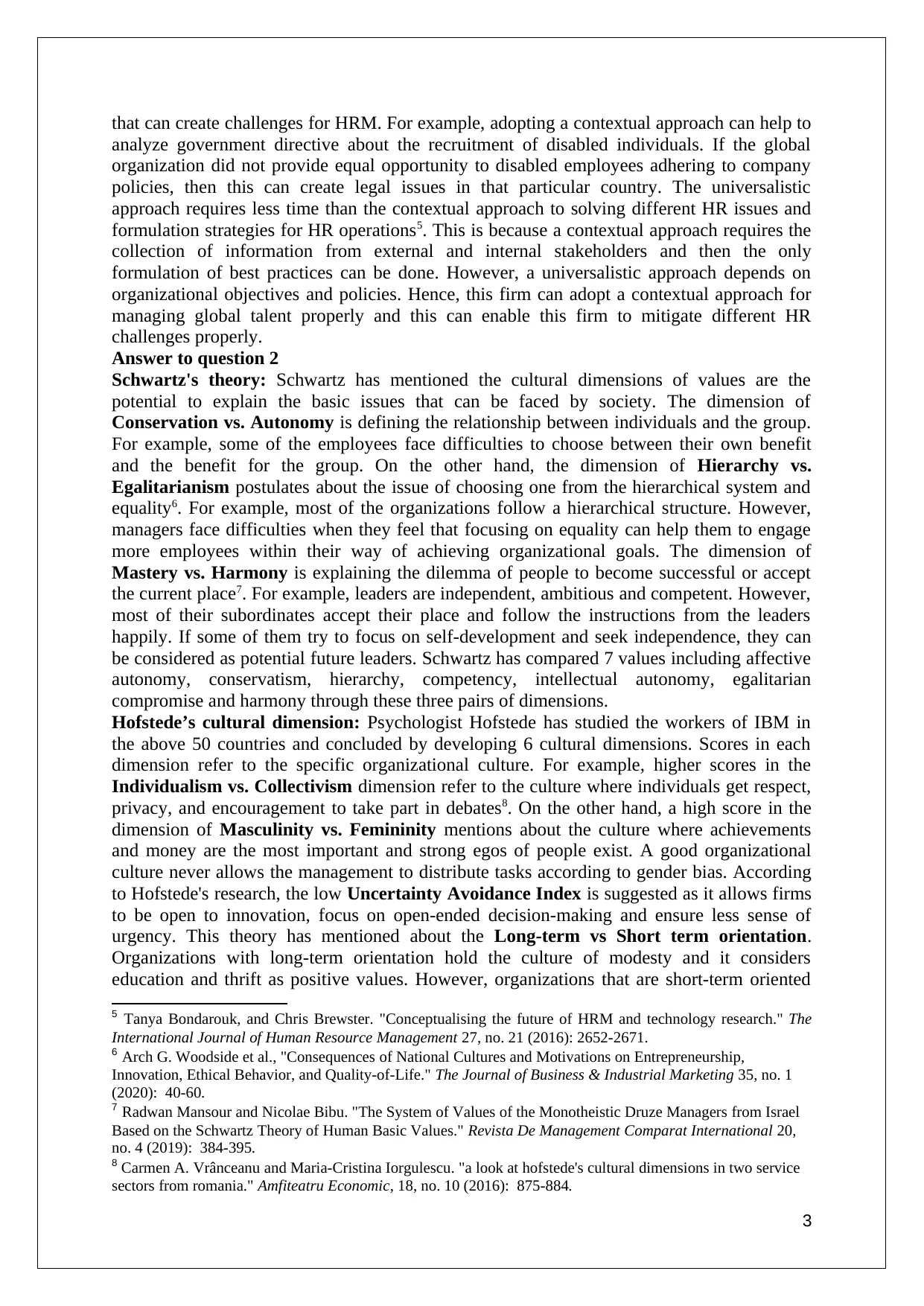
that can create challenges for HRM. For example, adopting a contextual approach can help to
analyze government directive about the recruitment of disabled individuals. If the global
organization did not provide equal opportunity to disabled employees adhering to company
policies, then this can create legal issues in that particular country. The universalistic
approach requires less time than the contextual approach to solving different HR issues and
formulation strategies for HR operations5. This is because a contextual approach requires the
collection of information from external and internal stakeholders and then the only
formulation of best practices can be done. However, a universalistic approach depends on
organizational objectives and policies. Hence, this firm can adopt a contextual approach for
managing global talent properly and this can enable this firm to mitigate different HR
challenges properly.
Answer to question 2
Schwartz's theory: Schwartz has mentioned the cultural dimensions of values are the
potential to explain the basic issues that can be faced by society. The dimension of
Conservation vs. Autonomy is defining the relationship between individuals and the group.
For example, some of the employees face difficulties to choose between their own benefit
and the benefit for the group. On the other hand, the dimension of Hierarchy vs.
Egalitarianism postulates about the issue of choosing one from the hierarchical system and
equality6. For example, most of the organizations follow a hierarchical structure. However,
managers face difficulties when they feel that focusing on equality can help them to engage
more employees within their way of achieving organizational goals. The dimension of
Mastery vs. Harmony is explaining the dilemma of people to become successful or accept
the current place7. For example, leaders are independent, ambitious and competent. However,
most of their subordinates accept their place and follow the instructions from the leaders
happily. If some of them try to focus on self-development and seek independence, they can
be considered as potential future leaders. Schwartz has compared 7 values including affective
autonomy, conservatism, hierarchy, competency, intellectual autonomy, egalitarian
compromise and harmony through these three pairs of dimensions.
Hofstede’s cultural dimension: Psychologist Hofstede has studied the workers of IBM in
the above 50 countries and concluded by developing 6 cultural dimensions. Scores in each
dimension refer to the specific organizational culture. For example, higher scores in the
Individualism vs. Collectivism dimension refer to the culture where individuals get respect,
privacy, and encouragement to take part in debates8. On the other hand, a high score in the
dimension of Masculinity vs. Femininity mentions about the culture where achievements
and money are the most important and strong egos of people exist. A good organizational
culture never allows the management to distribute tasks according to gender bias. According
to Hofstede's research, the low Uncertainty Avoidance Index is suggested as it allows firms
to be open to innovation, focus on open-ended decision-making and ensure less sense of
urgency. This theory has mentioned about the Long-term vs Short term orientation.
Organizations with long-term orientation hold the culture of modesty and it considers
education and thrift as positive values. However, organizations that are short-term oriented
5 Tanya Bondarouk, and Chris Brewster. "Conceptualising the future of HRM and technology research." The
International Journal of Human Resource Management 27, no. 21 (2016): 2652-2671.
6 Arch G. Woodside et al., "Consequences of National Cultures and Motivations on Entrepreneurship,
Innovation, Ethical Behavior, and Quality-of-Life." The Journal of Business & Industrial Marketing 35, no. 1
(2020): 40-60.
7 Radwan Mansour and Nicolae Bibu. "The System of Values of the Monotheistic Druze Managers from Israel
Based on the Schwartz Theory of Human Basic Values." Revista De Management Comparat International 20,
no. 4 (2019): 384-395.
8 Carmen A. Vrânceanu and Maria-Cristina Iorgulescu. "a look at hofstede's cultural dimensions in two service
sectors from romania." Amfiteatru Economic, 18, no. 10 (2016): 875-884.
3
analyze government directive about the recruitment of disabled individuals. If the global
organization did not provide equal opportunity to disabled employees adhering to company
policies, then this can create legal issues in that particular country. The universalistic
approach requires less time than the contextual approach to solving different HR issues and
formulation strategies for HR operations5. This is because a contextual approach requires the
collection of information from external and internal stakeholders and then the only
formulation of best practices can be done. However, a universalistic approach depends on
organizational objectives and policies. Hence, this firm can adopt a contextual approach for
managing global talent properly and this can enable this firm to mitigate different HR
challenges properly.
Answer to question 2
Schwartz's theory: Schwartz has mentioned the cultural dimensions of values are the
potential to explain the basic issues that can be faced by society. The dimension of
Conservation vs. Autonomy is defining the relationship between individuals and the group.
For example, some of the employees face difficulties to choose between their own benefit
and the benefit for the group. On the other hand, the dimension of Hierarchy vs.
Egalitarianism postulates about the issue of choosing one from the hierarchical system and
equality6. For example, most of the organizations follow a hierarchical structure. However,
managers face difficulties when they feel that focusing on equality can help them to engage
more employees within their way of achieving organizational goals. The dimension of
Mastery vs. Harmony is explaining the dilemma of people to become successful or accept
the current place7. For example, leaders are independent, ambitious and competent. However,
most of their subordinates accept their place and follow the instructions from the leaders
happily. If some of them try to focus on self-development and seek independence, they can
be considered as potential future leaders. Schwartz has compared 7 values including affective
autonomy, conservatism, hierarchy, competency, intellectual autonomy, egalitarian
compromise and harmony through these three pairs of dimensions.
Hofstede’s cultural dimension: Psychologist Hofstede has studied the workers of IBM in
the above 50 countries and concluded by developing 6 cultural dimensions. Scores in each
dimension refer to the specific organizational culture. For example, higher scores in the
Individualism vs. Collectivism dimension refer to the culture where individuals get respect,
privacy, and encouragement to take part in debates8. On the other hand, a high score in the
dimension of Masculinity vs. Femininity mentions about the culture where achievements
and money are the most important and strong egos of people exist. A good organizational
culture never allows the management to distribute tasks according to gender bias. According
to Hofstede's research, the low Uncertainty Avoidance Index is suggested as it allows firms
to be open to innovation, focus on open-ended decision-making and ensure less sense of
urgency. This theory has mentioned about the Long-term vs Short term orientation.
Organizations with long-term orientation hold the culture of modesty and it considers
education and thrift as positive values. However, organizations that are short-term oriented
5 Tanya Bondarouk, and Chris Brewster. "Conceptualising the future of HRM and technology research." The
International Journal of Human Resource Management 27, no. 21 (2016): 2652-2671.
6 Arch G. Woodside et al., "Consequences of National Cultures and Motivations on Entrepreneurship,
Innovation, Ethical Behavior, and Quality-of-Life." The Journal of Business & Industrial Marketing 35, no. 1
(2020): 40-60.
7 Radwan Mansour and Nicolae Bibu. "The System of Values of the Monotheistic Druze Managers from Israel
Based on the Schwartz Theory of Human Basic Values." Revista De Management Comparat International 20,
no. 4 (2019): 384-395.
8 Carmen A. Vrânceanu and Maria-Cristina Iorgulescu. "a look at hofstede's cultural dimensions in two service
sectors from romania." Amfiteatru Economic, 18, no. 10 (2016): 875-884.
3
⊘ This is a preview!⊘
Do you want full access?
Subscribe today to unlock all pages.

Trusted by 1+ million students worldwide
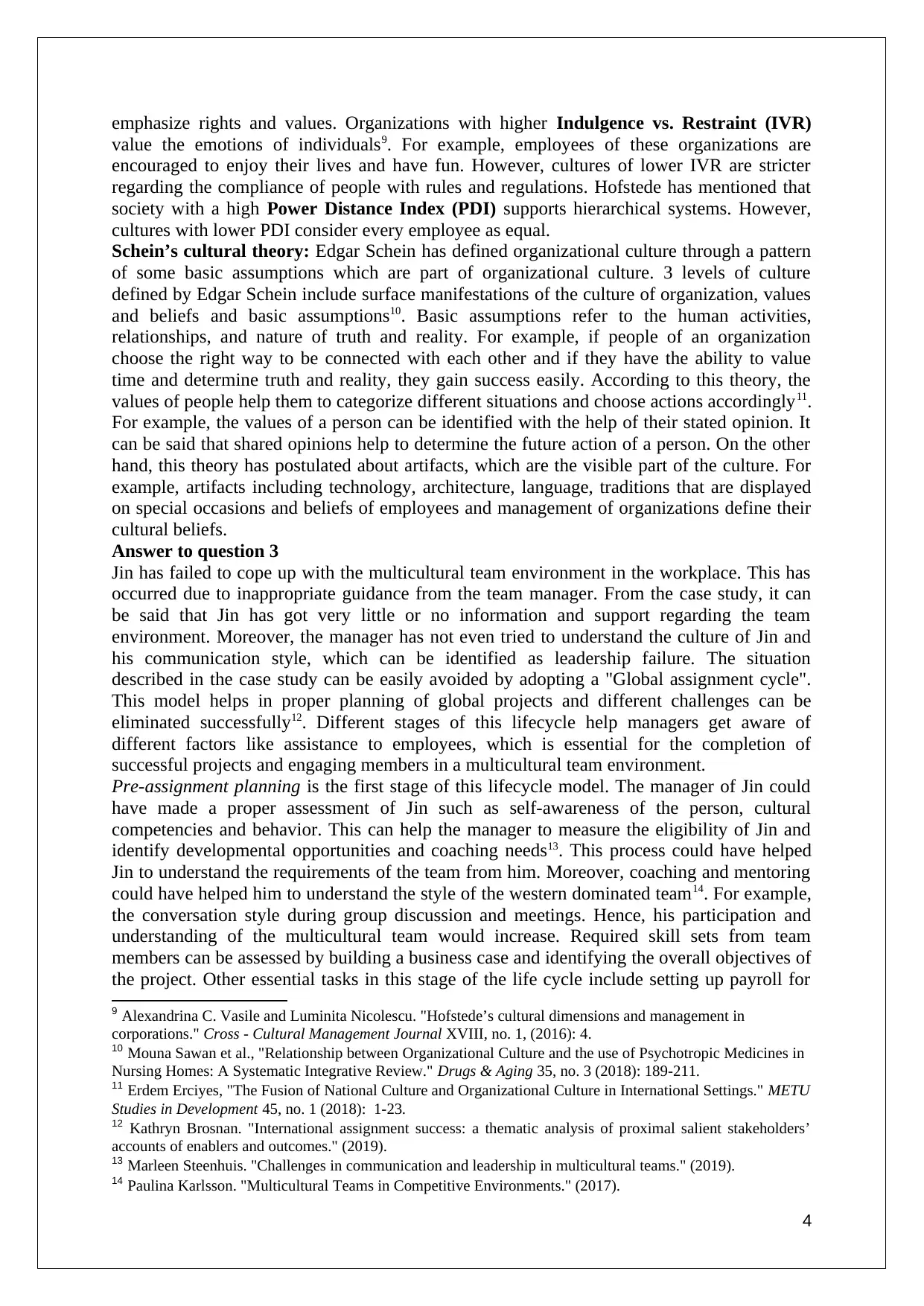
emphasize rights and values. Organizations with higher Indulgence vs. Restraint (IVR)
value the emotions of individuals9. For example, employees of these organizations are
encouraged to enjoy their lives and have fun. However, cultures of lower IVR are stricter
regarding the compliance of people with rules and regulations. Hofstede has mentioned that
society with a high Power Distance Index (PDI) supports hierarchical systems. However,
cultures with lower PDI consider every employee as equal.
Schein’s cultural theory: Edgar Schein has defined organizational culture through a pattern
of some basic assumptions which are part of organizational culture. 3 levels of culture
defined by Edgar Schein include surface manifestations of the culture of organization, values
and beliefs and basic assumptions10. Basic assumptions refer to the human activities,
relationships, and nature of truth and reality. For example, if people of an organization
choose the right way to be connected with each other and if they have the ability to value
time and determine truth and reality, they gain success easily. According to this theory, the
values of people help them to categorize different situations and choose actions accordingly11.
For example, the values of a person can be identified with the help of their stated opinion. It
can be said that shared opinions help to determine the future action of a person. On the other
hand, this theory has postulated about artifacts, which are the visible part of the culture. For
example, artifacts including technology, architecture, language, traditions that are displayed
on special occasions and beliefs of employees and management of organizations define their
cultural beliefs.
Answer to question 3
Jin has failed to cope up with the multicultural team environment in the workplace. This has
occurred due to inappropriate guidance from the team manager. From the case study, it can
be said that Jin has got very little or no information and support regarding the team
environment. Moreover, the manager has not even tried to understand the culture of Jin and
his communication style, which can be identified as leadership failure. The situation
described in the case study can be easily avoided by adopting a "Global assignment cycle".
This model helps in proper planning of global projects and different challenges can be
eliminated successfully12. Different stages of this lifecycle help managers get aware of
different factors like assistance to employees, which is essential for the completion of
successful projects and engaging members in a multicultural team environment.
Pre-assignment planning is the first stage of this lifecycle model. The manager of Jin could
have made a proper assessment of Jin such as self-awareness of the person, cultural
competencies and behavior. This can help the manager to measure the eligibility of Jin and
identify developmental opportunities and coaching needs13. This process could have helped
Jin to understand the requirements of the team from him. Moreover, coaching and mentoring
could have helped him to understand the style of the western dominated team14. For example,
the conversation style during group discussion and meetings. Hence, his participation and
understanding of the multicultural team would increase. Required skill sets from team
members can be assessed by building a business case and identifying the overall objectives of
the project. Other essential tasks in this stage of the life cycle include setting up payroll for
9 Alexandrina C. Vasile and Luminita Nicolescu. "Hofstede’s cultural dimensions and management in
corporations." Cross - Cultural Management Journal XVIII, no. 1, (2016): 4.
10 Mouna Sawan et al., "Relationship between Organizational Culture and the use of Psychotropic Medicines in
Nursing Homes: A Systematic Integrative Review." Drugs & Aging 35, no. 3 (2018): 189-211.
11 Erdem Erciyes, "The Fusion of National Culture and Organizational Culture in International Settings." METU
Studies in Development 45, no. 1 (2018): 1-23.
12 Kathryn Brosnan. "International assignment success: a thematic analysis of proximal salient stakeholders’
accounts of enablers and outcomes." (2019).
13 Marleen Steenhuis. "Challenges in communication and leadership in multicultural teams." (2019).
14 Paulina Karlsson. "Multicultural Teams in Competitive Environments." (2017).
4
value the emotions of individuals9. For example, employees of these organizations are
encouraged to enjoy their lives and have fun. However, cultures of lower IVR are stricter
regarding the compliance of people with rules and regulations. Hofstede has mentioned that
society with a high Power Distance Index (PDI) supports hierarchical systems. However,
cultures with lower PDI consider every employee as equal.
Schein’s cultural theory: Edgar Schein has defined organizational culture through a pattern
of some basic assumptions which are part of organizational culture. 3 levels of culture
defined by Edgar Schein include surface manifestations of the culture of organization, values
and beliefs and basic assumptions10. Basic assumptions refer to the human activities,
relationships, and nature of truth and reality. For example, if people of an organization
choose the right way to be connected with each other and if they have the ability to value
time and determine truth and reality, they gain success easily. According to this theory, the
values of people help them to categorize different situations and choose actions accordingly11.
For example, the values of a person can be identified with the help of their stated opinion. It
can be said that shared opinions help to determine the future action of a person. On the other
hand, this theory has postulated about artifacts, which are the visible part of the culture. For
example, artifacts including technology, architecture, language, traditions that are displayed
on special occasions and beliefs of employees and management of organizations define their
cultural beliefs.
Answer to question 3
Jin has failed to cope up with the multicultural team environment in the workplace. This has
occurred due to inappropriate guidance from the team manager. From the case study, it can
be said that Jin has got very little or no information and support regarding the team
environment. Moreover, the manager has not even tried to understand the culture of Jin and
his communication style, which can be identified as leadership failure. The situation
described in the case study can be easily avoided by adopting a "Global assignment cycle".
This model helps in proper planning of global projects and different challenges can be
eliminated successfully12. Different stages of this lifecycle help managers get aware of
different factors like assistance to employees, which is essential for the completion of
successful projects and engaging members in a multicultural team environment.
Pre-assignment planning is the first stage of this lifecycle model. The manager of Jin could
have made a proper assessment of Jin such as self-awareness of the person, cultural
competencies and behavior. This can help the manager to measure the eligibility of Jin and
identify developmental opportunities and coaching needs13. This process could have helped
Jin to understand the requirements of the team from him. Moreover, coaching and mentoring
could have helped him to understand the style of the western dominated team14. For example,
the conversation style during group discussion and meetings. Hence, his participation and
understanding of the multicultural team would increase. Required skill sets from team
members can be assessed by building a business case and identifying the overall objectives of
the project. Other essential tasks in this stage of the life cycle include setting up payroll for
9 Alexandrina C. Vasile and Luminita Nicolescu. "Hofstede’s cultural dimensions and management in
corporations." Cross - Cultural Management Journal XVIII, no. 1, (2016): 4.
10 Mouna Sawan et al., "Relationship between Organizational Culture and the use of Psychotropic Medicines in
Nursing Homes: A Systematic Integrative Review." Drugs & Aging 35, no. 3 (2018): 189-211.
11 Erdem Erciyes, "The Fusion of National Culture and Organizational Culture in International Settings." METU
Studies in Development 45, no. 1 (2018): 1-23.
12 Kathryn Brosnan. "International assignment success: a thematic analysis of proximal salient stakeholders’
accounts of enablers and outcomes." (2019).
13 Marleen Steenhuis. "Challenges in communication and leadership in multicultural teams." (2019).
14 Paulina Karlsson. "Multicultural Teams in Competitive Environments." (2017).
4
Paraphrase This Document
Need a fresh take? Get an instant paraphrase of this document with our AI Paraphraser
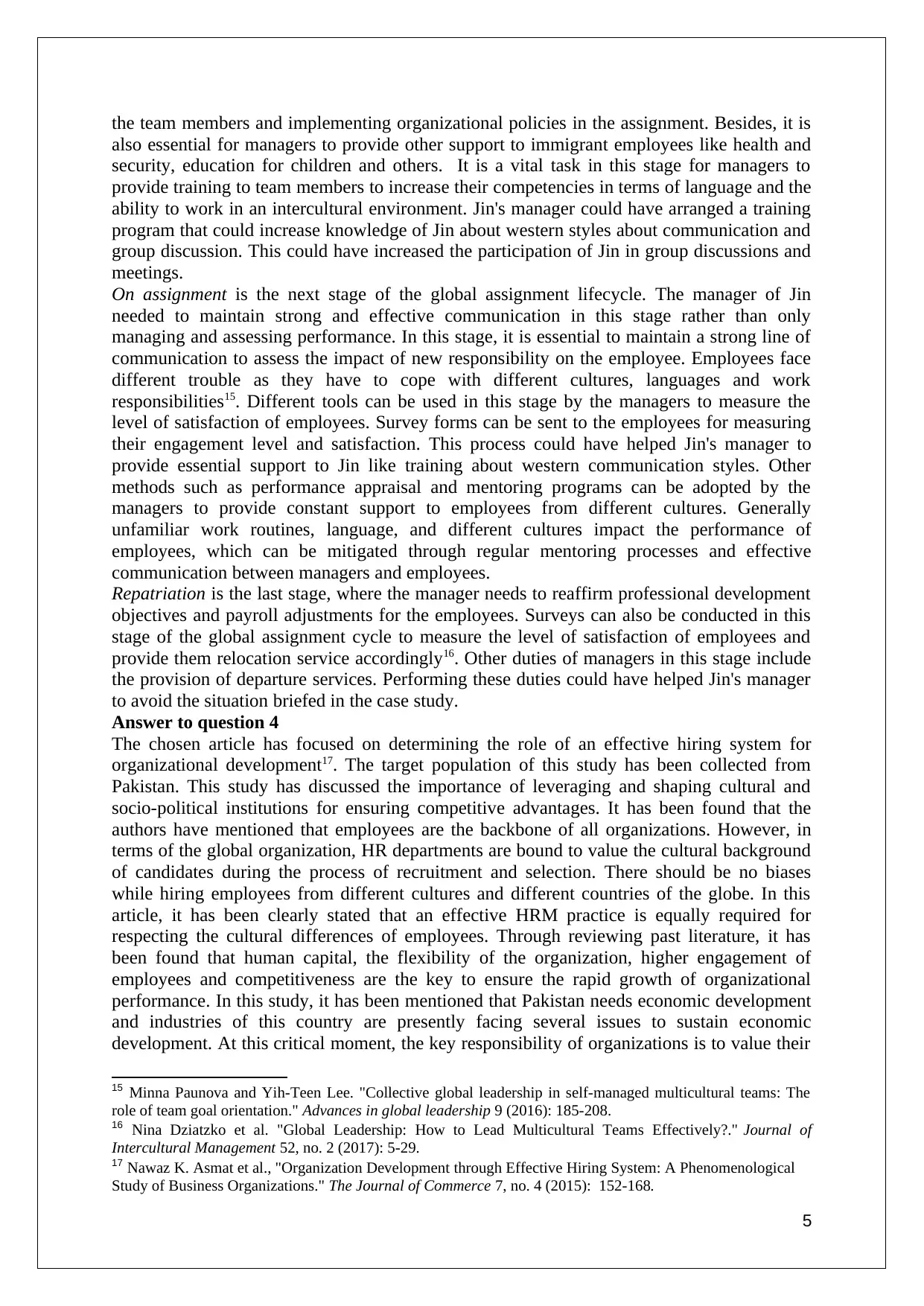
the team members and implementing organizational policies in the assignment. Besides, it is
also essential for managers to provide other support to immigrant employees like health and
security, education for children and others. It is a vital task in this stage for managers to
provide training to team members to increase their competencies in terms of language and the
ability to work in an intercultural environment. Jin's manager could have arranged a training
program that could increase knowledge of Jin about western styles about communication and
group discussion. This could have increased the participation of Jin in group discussions and
meetings.
On assignment is the next stage of the global assignment lifecycle. The manager of Jin
needed to maintain strong and effective communication in this stage rather than only
managing and assessing performance. In this stage, it is essential to maintain a strong line of
communication to assess the impact of new responsibility on the employee. Employees face
different trouble as they have to cope with different cultures, languages and work
responsibilities15. Different tools can be used in this stage by the managers to measure the
level of satisfaction of employees. Survey forms can be sent to the employees for measuring
their engagement level and satisfaction. This process could have helped Jin's manager to
provide essential support to Jin like training about western communication styles. Other
methods such as performance appraisal and mentoring programs can be adopted by the
managers to provide constant support to employees from different cultures. Generally
unfamiliar work routines, language, and different cultures impact the performance of
employees, which can be mitigated through regular mentoring processes and effective
communication between managers and employees.
Repatriation is the last stage, where the manager needs to reaffirm professional development
objectives and payroll adjustments for the employees. Surveys can also be conducted in this
stage of the global assignment cycle to measure the level of satisfaction of employees and
provide them relocation service accordingly16. Other duties of managers in this stage include
the provision of departure services. Performing these duties could have helped Jin's manager
to avoid the situation briefed in the case study.
Answer to question 4
The chosen article has focused on determining the role of an effective hiring system for
organizational development17. The target population of this study has been collected from
Pakistan. This study has discussed the importance of leveraging and shaping cultural and
socio-political institutions for ensuring competitive advantages. It has been found that the
authors have mentioned that employees are the backbone of all organizations. However, in
terms of the global organization, HR departments are bound to value the cultural background
of candidates during the process of recruitment and selection. There should be no biases
while hiring employees from different cultures and different countries of the globe. In this
article, it has been clearly stated that an effective HRM practice is equally required for
respecting the cultural differences of employees. Through reviewing past literature, it has
been found that human capital, the flexibility of the organization, higher engagement of
employees and competitiveness are the key to ensure the rapid growth of organizational
performance. In this study, it has been mentioned that Pakistan needs economic development
and industries of this country are presently facing several issues to sustain economic
development. At this critical moment, the key responsibility of organizations is to value their
15 Minna Paunova and Yih-Teen Lee. "Collective global leadership in self-managed multicultural teams: The
role of team goal orientation." Advances in global leadership 9 (2016): 185-208.
16 Nina Dziatzko et al. "Global Leadership: How to Lead Multicultural Teams Effectively?." Journal of
Intercultural Management 52, no. 2 (2017): 5-29.
17 Nawaz K. Asmat et al., "Organization Development through Effective Hiring System: A Phenomenological
Study of Business Organizations." The Journal of Commerce 7, no. 4 (2015): 152-168.
5
also essential for managers to provide other support to immigrant employees like health and
security, education for children and others. It is a vital task in this stage for managers to
provide training to team members to increase their competencies in terms of language and the
ability to work in an intercultural environment. Jin's manager could have arranged a training
program that could increase knowledge of Jin about western styles about communication and
group discussion. This could have increased the participation of Jin in group discussions and
meetings.
On assignment is the next stage of the global assignment lifecycle. The manager of Jin
needed to maintain strong and effective communication in this stage rather than only
managing and assessing performance. In this stage, it is essential to maintain a strong line of
communication to assess the impact of new responsibility on the employee. Employees face
different trouble as they have to cope with different cultures, languages and work
responsibilities15. Different tools can be used in this stage by the managers to measure the
level of satisfaction of employees. Survey forms can be sent to the employees for measuring
their engagement level and satisfaction. This process could have helped Jin's manager to
provide essential support to Jin like training about western communication styles. Other
methods such as performance appraisal and mentoring programs can be adopted by the
managers to provide constant support to employees from different cultures. Generally
unfamiliar work routines, language, and different cultures impact the performance of
employees, which can be mitigated through regular mentoring processes and effective
communication between managers and employees.
Repatriation is the last stage, where the manager needs to reaffirm professional development
objectives and payroll adjustments for the employees. Surveys can also be conducted in this
stage of the global assignment cycle to measure the level of satisfaction of employees and
provide them relocation service accordingly16. Other duties of managers in this stage include
the provision of departure services. Performing these duties could have helped Jin's manager
to avoid the situation briefed in the case study.
Answer to question 4
The chosen article has focused on determining the role of an effective hiring system for
organizational development17. The target population of this study has been collected from
Pakistan. This study has discussed the importance of leveraging and shaping cultural and
socio-political institutions for ensuring competitive advantages. It has been found that the
authors have mentioned that employees are the backbone of all organizations. However, in
terms of the global organization, HR departments are bound to value the cultural background
of candidates during the process of recruitment and selection. There should be no biases
while hiring employees from different cultures and different countries of the globe. In this
article, it has been clearly stated that an effective HRM practice is equally required for
respecting the cultural differences of employees. Through reviewing past literature, it has
been found that human capital, the flexibility of the organization, higher engagement of
employees and competitiveness are the key to ensure the rapid growth of organizational
performance. In this study, it has been mentioned that Pakistan needs economic development
and industries of this country are presently facing several issues to sustain economic
development. At this critical moment, the key responsibility of organizations is to value their
15 Minna Paunova and Yih-Teen Lee. "Collective global leadership in self-managed multicultural teams: The
role of team goal orientation." Advances in global leadership 9 (2016): 185-208.
16 Nina Dziatzko et al. "Global Leadership: How to Lead Multicultural Teams Effectively?." Journal of
Intercultural Management 52, no. 2 (2017): 5-29.
17 Nawaz K. Asmat et al., "Organization Development through Effective Hiring System: A Phenomenological
Study of Business Organizations." The Journal of Commerce 7, no. 4 (2015): 152-168.
5
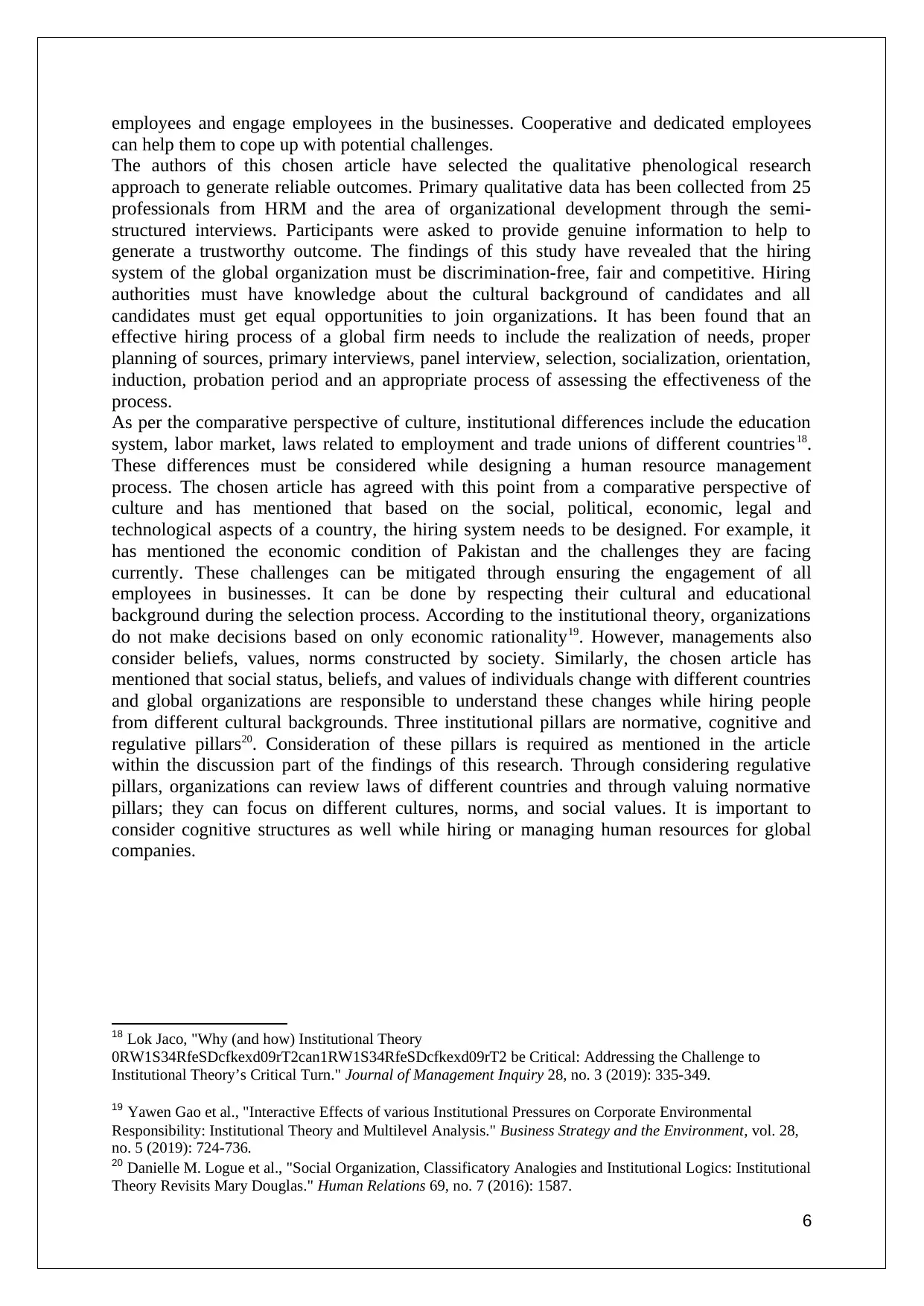
employees and engage employees in the businesses. Cooperative and dedicated employees
can help them to cope up with potential challenges.
The authors of this chosen article have selected the qualitative phenological research
approach to generate reliable outcomes. Primary qualitative data has been collected from 25
professionals from HRM and the area of organizational development through the semi-
structured interviews. Participants were asked to provide genuine information to help to
generate a trustworthy outcome. The findings of this study have revealed that the hiring
system of the global organization must be discrimination-free, fair and competitive. Hiring
authorities must have knowledge about the cultural background of candidates and all
candidates must get equal opportunities to join organizations. It has been found that an
effective hiring process of a global firm needs to include the realization of needs, proper
planning of sources, primary interviews, panel interview, selection, socialization, orientation,
induction, probation period and an appropriate process of assessing the effectiveness of the
process.
As per the comparative perspective of culture, institutional differences include the education
system, labor market, laws related to employment and trade unions of different countries18.
These differences must be considered while designing a human resource management
process. The chosen article has agreed with this point from a comparative perspective of
culture and has mentioned that based on the social, political, economic, legal and
technological aspects of a country, the hiring system needs to be designed. For example, it
has mentioned the economic condition of Pakistan and the challenges they are facing
currently. These challenges can be mitigated through ensuring the engagement of all
employees in businesses. It can be done by respecting their cultural and educational
background during the selection process. According to the institutional theory, organizations
do not make decisions based on only economic rationality19. However, managements also
consider beliefs, values, norms constructed by society. Similarly, the chosen article has
mentioned that social status, beliefs, and values of individuals change with different countries
and global organizations are responsible to understand these changes while hiring people
from different cultural backgrounds. Three institutional pillars are normative, cognitive and
regulative pillars20. Consideration of these pillars is required as mentioned in the article
within the discussion part of the findings of this research. Through considering regulative
pillars, organizations can review laws of different countries and through valuing normative
pillars; they can focus on different cultures, norms, and social values. It is important to
consider cognitive structures as well while hiring or managing human resources for global
companies.
18 Lok Jaco, "Why (and how) Institutional Theory
0RW1S34RfeSDcfkexd09rT2can1RW1S34RfeSDcfkexd09rT2 be Critical: Addressing the Challenge to
Institutional Theory’s Critical Turn." Journal of Management Inquiry 28, no. 3 (2019): 335-349.
19 Yawen Gao et al., "Interactive Effects of various Institutional Pressures on Corporate Environmental
Responsibility: Institutional Theory and Multilevel Analysis." Business Strategy and the Environment, vol. 28,
no. 5 (2019): 724-736.
20 Danielle M. Logue et al., "Social Organization, Classificatory Analogies and Institutional Logics: Institutional
Theory Revisits Mary Douglas." Human Relations 69, no. 7 (2016): 1587.
6
can help them to cope up with potential challenges.
The authors of this chosen article have selected the qualitative phenological research
approach to generate reliable outcomes. Primary qualitative data has been collected from 25
professionals from HRM and the area of organizational development through the semi-
structured interviews. Participants were asked to provide genuine information to help to
generate a trustworthy outcome. The findings of this study have revealed that the hiring
system of the global organization must be discrimination-free, fair and competitive. Hiring
authorities must have knowledge about the cultural background of candidates and all
candidates must get equal opportunities to join organizations. It has been found that an
effective hiring process of a global firm needs to include the realization of needs, proper
planning of sources, primary interviews, panel interview, selection, socialization, orientation,
induction, probation period and an appropriate process of assessing the effectiveness of the
process.
As per the comparative perspective of culture, institutional differences include the education
system, labor market, laws related to employment and trade unions of different countries18.
These differences must be considered while designing a human resource management
process. The chosen article has agreed with this point from a comparative perspective of
culture and has mentioned that based on the social, political, economic, legal and
technological aspects of a country, the hiring system needs to be designed. For example, it
has mentioned the economic condition of Pakistan and the challenges they are facing
currently. These challenges can be mitigated through ensuring the engagement of all
employees in businesses. It can be done by respecting their cultural and educational
background during the selection process. According to the institutional theory, organizations
do not make decisions based on only economic rationality19. However, managements also
consider beliefs, values, norms constructed by society. Similarly, the chosen article has
mentioned that social status, beliefs, and values of individuals change with different countries
and global organizations are responsible to understand these changes while hiring people
from different cultural backgrounds. Three institutional pillars are normative, cognitive and
regulative pillars20. Consideration of these pillars is required as mentioned in the article
within the discussion part of the findings of this research. Through considering regulative
pillars, organizations can review laws of different countries and through valuing normative
pillars; they can focus on different cultures, norms, and social values. It is important to
consider cognitive structures as well while hiring or managing human resources for global
companies.
18 Lok Jaco, "Why (and how) Institutional Theory
0RW1S34RfeSDcfkexd09rT2can1RW1S34RfeSDcfkexd09rT2 be Critical: Addressing the Challenge to
Institutional Theory’s Critical Turn." Journal of Management Inquiry 28, no. 3 (2019): 335-349.
19 Yawen Gao et al., "Interactive Effects of various Institutional Pressures on Corporate Environmental
Responsibility: Institutional Theory and Multilevel Analysis." Business Strategy and the Environment, vol. 28,
no. 5 (2019): 724-736.
20 Danielle M. Logue et al., "Social Organization, Classificatory Analogies and Institutional Logics: Institutional
Theory Revisits Mary Douglas." Human Relations 69, no. 7 (2016): 1587.
6
⊘ This is a preview!⊘
Do you want full access?
Subscribe today to unlock all pages.

Trusted by 1+ million students worldwide
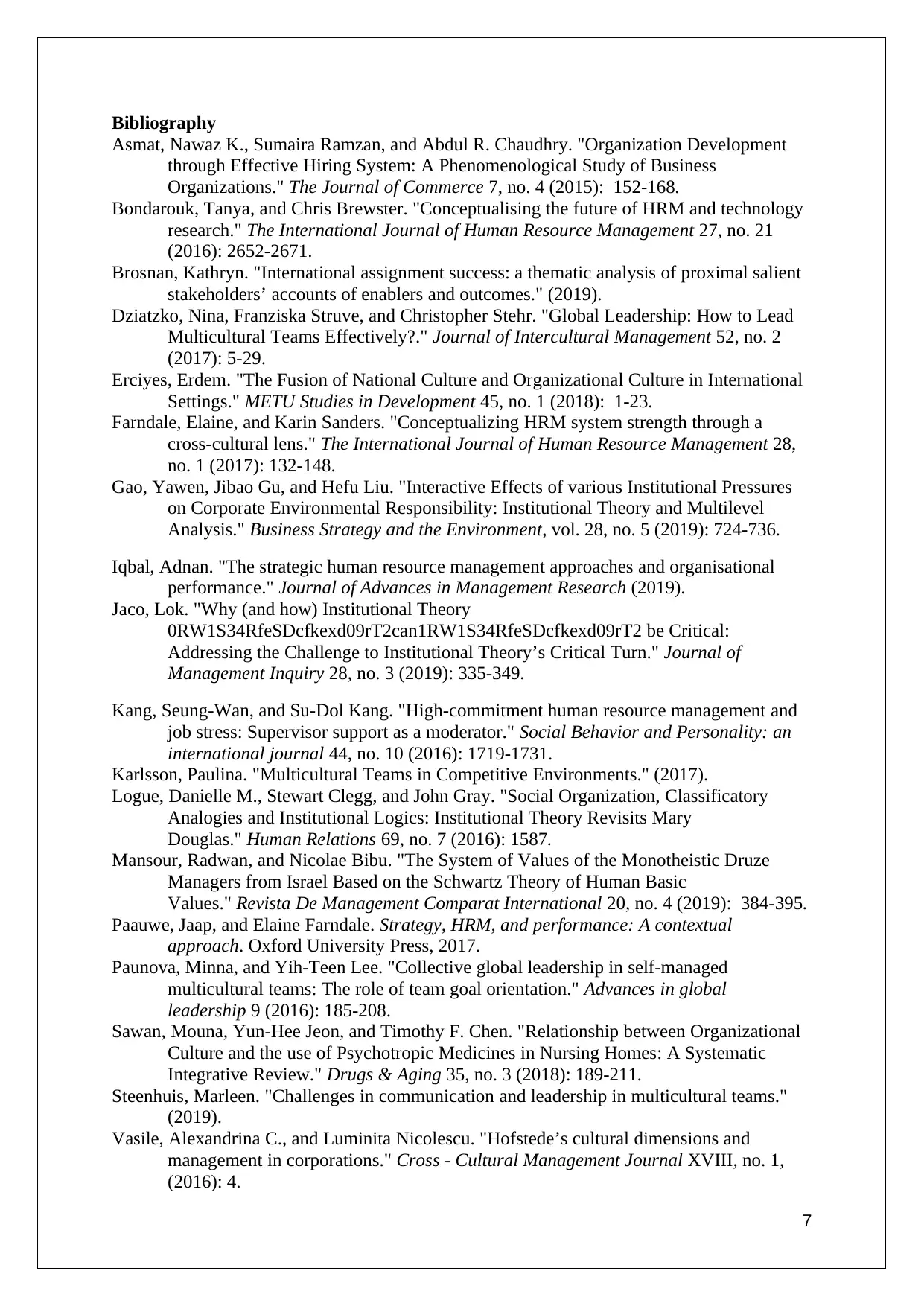
Bibliography
Asmat, Nawaz K., Sumaira Ramzan, and Abdul R. Chaudhry. "Organization Development
through Effective Hiring System: A Phenomenological Study of Business
Organizations." The Journal of Commerce 7, no. 4 (2015): 152-168.
Bondarouk, Tanya, and Chris Brewster. "Conceptualising the future of HRM and technology
research." The International Journal of Human Resource Management 27, no. 21
(2016): 2652-2671.
Brosnan, Kathryn. "International assignment success: a thematic analysis of proximal salient
stakeholders’ accounts of enablers and outcomes." (2019).
Dziatzko, Nina, Franziska Struve, and Christopher Stehr. "Global Leadership: How to Lead
Multicultural Teams Effectively?." Journal of Intercultural Management 52, no. 2
(2017): 5-29.
Erciyes, Erdem. "The Fusion of National Culture and Organizational Culture in International
Settings." METU Studies in Development 45, no. 1 (2018): 1-23.
Farndale, Elaine, and Karin Sanders. "Conceptualizing HRM system strength through a
cross-cultural lens." The International Journal of Human Resource Management 28,
no. 1 (2017): 132-148.
Gao, Yawen, Jibao Gu, and Hefu Liu. "Interactive Effects of various Institutional Pressures
on Corporate Environmental Responsibility: Institutional Theory and Multilevel
Analysis." Business Strategy and the Environment, vol. 28, no. 5 (2019): 724-736.
Iqbal, Adnan. "The strategic human resource management approaches and organisational
performance." Journal of Advances in Management Research (2019).
Jaco, Lok. "Why (and how) Institutional Theory
0RW1S34RfeSDcfkexd09rT2can1RW1S34RfeSDcfkexd09rT2 be Critical:
Addressing the Challenge to Institutional Theory’s Critical Turn." Journal of
Management Inquiry 28, no. 3 (2019): 335-349.
Kang, Seung-Wan, and Su-Dol Kang. "High-commitment human resource management and
job stress: Supervisor support as a moderator." Social Behavior and Personality: an
international journal 44, no. 10 (2016): 1719-1731.
Karlsson, Paulina. "Multicultural Teams in Competitive Environments." (2017).
Logue, Danielle M., Stewart Clegg, and John Gray. "Social Organization, Classificatory
Analogies and Institutional Logics: Institutional Theory Revisits Mary
Douglas." Human Relations 69, no. 7 (2016): 1587.
Mansour, Radwan, and Nicolae Bibu. "The System of Values of the Monotheistic Druze
Managers from Israel Based on the Schwartz Theory of Human Basic
Values." Revista De Management Comparat International 20, no. 4 (2019): 384-395.
Paauwe, Jaap, and Elaine Farndale. Strategy, HRM, and performance: A contextual
approach. Oxford University Press, 2017.
Paunova, Minna, and Yih-Teen Lee. "Collective global leadership in self-managed
multicultural teams: The role of team goal orientation." Advances in global
leadership 9 (2016): 185-208.
Sawan, Mouna, Yun-Hee Jeon, and Timothy F. Chen. "Relationship between Organizational
Culture and the use of Psychotropic Medicines in Nursing Homes: A Systematic
Integrative Review." Drugs & Aging 35, no. 3 (2018): 189-211.
Steenhuis, Marleen. "Challenges in communication and leadership in multicultural teams."
(2019).
Vasile, Alexandrina C., and Luminita Nicolescu. "Hofstede’s cultural dimensions and
management in corporations." Cross - Cultural Management Journal XVIII, no. 1,
(2016): 4.
7
Asmat, Nawaz K., Sumaira Ramzan, and Abdul R. Chaudhry. "Organization Development
through Effective Hiring System: A Phenomenological Study of Business
Organizations." The Journal of Commerce 7, no. 4 (2015): 152-168.
Bondarouk, Tanya, and Chris Brewster. "Conceptualising the future of HRM and technology
research." The International Journal of Human Resource Management 27, no. 21
(2016): 2652-2671.
Brosnan, Kathryn. "International assignment success: a thematic analysis of proximal salient
stakeholders’ accounts of enablers and outcomes." (2019).
Dziatzko, Nina, Franziska Struve, and Christopher Stehr. "Global Leadership: How to Lead
Multicultural Teams Effectively?." Journal of Intercultural Management 52, no. 2
(2017): 5-29.
Erciyes, Erdem. "The Fusion of National Culture and Organizational Culture in International
Settings." METU Studies in Development 45, no. 1 (2018): 1-23.
Farndale, Elaine, and Karin Sanders. "Conceptualizing HRM system strength through a
cross-cultural lens." The International Journal of Human Resource Management 28,
no. 1 (2017): 132-148.
Gao, Yawen, Jibao Gu, and Hefu Liu. "Interactive Effects of various Institutional Pressures
on Corporate Environmental Responsibility: Institutional Theory and Multilevel
Analysis." Business Strategy and the Environment, vol. 28, no. 5 (2019): 724-736.
Iqbal, Adnan. "The strategic human resource management approaches and organisational
performance." Journal of Advances in Management Research (2019).
Jaco, Lok. "Why (and how) Institutional Theory
0RW1S34RfeSDcfkexd09rT2can1RW1S34RfeSDcfkexd09rT2 be Critical:
Addressing the Challenge to Institutional Theory’s Critical Turn." Journal of
Management Inquiry 28, no. 3 (2019): 335-349.
Kang, Seung-Wan, and Su-Dol Kang. "High-commitment human resource management and
job stress: Supervisor support as a moderator." Social Behavior and Personality: an
international journal 44, no. 10 (2016): 1719-1731.
Karlsson, Paulina. "Multicultural Teams in Competitive Environments." (2017).
Logue, Danielle M., Stewart Clegg, and John Gray. "Social Organization, Classificatory
Analogies and Institutional Logics: Institutional Theory Revisits Mary
Douglas." Human Relations 69, no. 7 (2016): 1587.
Mansour, Radwan, and Nicolae Bibu. "The System of Values of the Monotheistic Druze
Managers from Israel Based on the Schwartz Theory of Human Basic
Values." Revista De Management Comparat International 20, no. 4 (2019): 384-395.
Paauwe, Jaap, and Elaine Farndale. Strategy, HRM, and performance: A contextual
approach. Oxford University Press, 2017.
Paunova, Minna, and Yih-Teen Lee. "Collective global leadership in self-managed
multicultural teams: The role of team goal orientation." Advances in global
leadership 9 (2016): 185-208.
Sawan, Mouna, Yun-Hee Jeon, and Timothy F. Chen. "Relationship between Organizational
Culture and the use of Psychotropic Medicines in Nursing Homes: A Systematic
Integrative Review." Drugs & Aging 35, no. 3 (2018): 189-211.
Steenhuis, Marleen. "Challenges in communication and leadership in multicultural teams."
(2019).
Vasile, Alexandrina C., and Luminita Nicolescu. "Hofstede’s cultural dimensions and
management in corporations." Cross - Cultural Management Journal XVIII, no. 1,
(2016): 4.
7
Paraphrase This Document
Need a fresh take? Get an instant paraphrase of this document with our AI Paraphraser
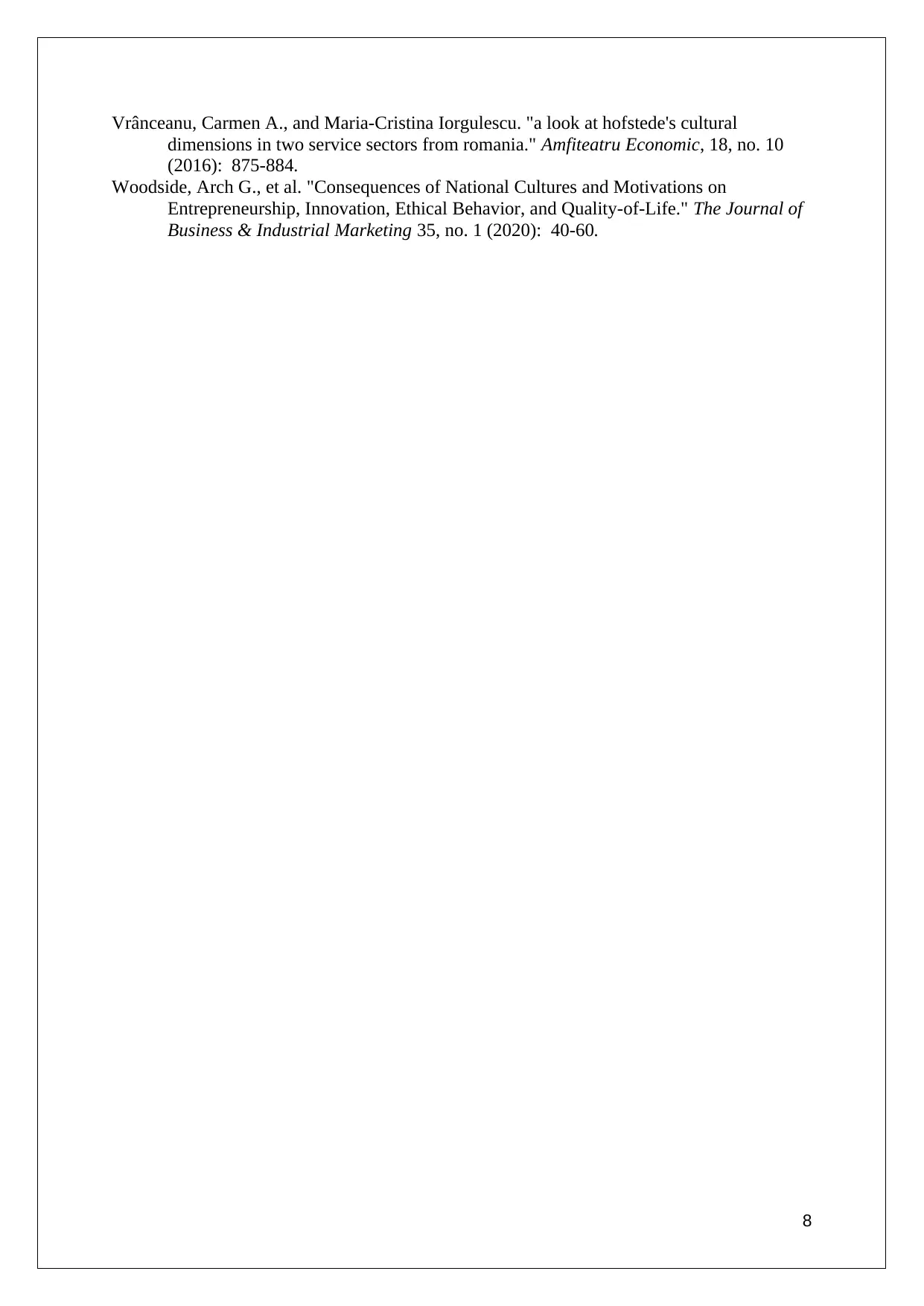
Vrânceanu, Carmen A., and Maria-Cristina Iorgulescu. "a look at hofstede's cultural
dimensions in two service sectors from romania." Amfiteatru Economic, 18, no. 10
(2016): 875-884.
Woodside, Arch G., et al. "Consequences of National Cultures and Motivations on
Entrepreneurship, Innovation, Ethical Behavior, and Quality-of-Life." The Journal of
Business & Industrial Marketing 35, no. 1 (2020): 40-60.
8
dimensions in two service sectors from romania." Amfiteatru Economic, 18, no. 10
(2016): 875-884.
Woodside, Arch G., et al. "Consequences of National Cultures and Motivations on
Entrepreneurship, Innovation, Ethical Behavior, and Quality-of-Life." The Journal of
Business & Industrial Marketing 35, no. 1 (2020): 40-60.
8
1 out of 8
Related Documents
Your All-in-One AI-Powered Toolkit for Academic Success.
+13062052269
info@desklib.com
Available 24*7 on WhatsApp / Email
![[object Object]](/_next/static/media/star-bottom.7253800d.svg)
Unlock your academic potential
Copyright © 2020–2025 A2Z Services. All Rights Reserved. Developed and managed by ZUCOL.



